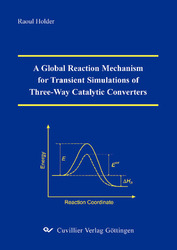| Fachbereiche | |
|---|---|
| Buchreihen (96) |
1378
|
| Nachhaltigkeit |
3
|
| Gesundheitswesen |
1
|
| Geisteswissenschaften |
2364
|
| Naturwissenschaften |
5406
|
| Ingenieurwissenschaften |
1793
|
| Allgemeine Ingenieurwissenschaften | 292 |
| Maschinenbau und Verfahrenstechnik | 862 |
| Elektrotechnik | 686 |
| Bergbau- und Hüttenwesen | 30 |
| Architektur und Bauwesen | 75 |
| Allgemein |
98
|
|
Leitlinien Unfallchirurgie
5. Auflage bestellen |
|
Erweiterte Suche
A Global Reaction Mechanism for Transient Simulations of Three-Way Catalytic Converters
Raoul Holder (Autor)Vorschau
Inhaltsverzeichnis, Datei (38 KB)
Leseprobe, Datei (100 KB)
The complex interactions between chemical kinetics and transport phenomena of mass, momentum and energy lead to incomplete fuel combustion, which is the origin of pollutant formation of internal combustion engines. Vehicle exhaust gas emission control devices have continuously been improved to meet the constantly tightened standards. Three-way catalyst technology is extensively used for the purification of automotive exhaust gases, usually in combination with monolithic (honeycomb) reactors. A promising alternative to the time consuming and costly engine and vehicle experiments are catalytic reactor model.
In this work a global reaction mechanism for three-way catalysts is developed including 16 reactions and 12 gas phase species. The reaction mechanism is combined with an empirical oxygen storage model and validated against a number of different real engine experiments carried out on both fresh (not aged) and aged catalysts. Once the mechanism is validated against the fresh system, the adaption to the aged system is achieved solely by the reduction of the available reactive surface area of the washcoat, without tuning the individual reaction parameters. Finally the parameter set of the aged system is used to simulate a FTP75 drive cycle and the results are compared to experimental data of the same catalyst without further tuning.
First a transient one-dimensional catalyst model is derived in chapter 2. First a short introduction to the structure of monolithic reactors is given, followed by the introduction of the governing equations for catalytically reacting flows. Chapter 3 focuses on the relevant transport processes inside the monolithic reactor channel and the adequacy of the transport models applied here. Local distributions of Nusselt and Sherwood numbers inside a monolith channel are resolved using a two-dimensional model. The cases of non-reacting and reacting conditions at the channel wall are discussed and subsequently compared to according a priori correlations. The subject of chapter 4 is the development and validation of the reaction mechanism. An advanced multi-objective optimization algorithm is used to calibrate the kinetic parameters of the presented reaction mechanism (comprising 16 reactions) to match the conversion behavior of a fresh catalyst. The simulation results are compared with experimental data at different operating conditions. In a second step the kinetic model is then used to simulate the conversion behavior of an aged catalyst. The adaption of the kinetic model is achieved only by the reduction of the available surface area. Again the computed conversion characteristics are compared to measured data. Finally an empirical oxygen storage model is included. In chapter 5 the catalyst model for the aged system is used to predict the tailpipe emissions during real drive cycle conditions. Finally a catalyst design parameter study is presented as a typical application of the model within the development process of exhaust gas aftertreatment systems.
| ISBN-13 (Printausgabe) | 3867277281 |
| ISBN-13 (Printausgabe) | 9783867277280 |
| ISBN-13 (E-Book) | 9783736927285 |
| Sprache | Englisch |
| Seitenanzahl | 148 |
| Auflage | 1 Aufl. |
| Band | 0 |
| Erscheinungsort | Göttingen |
| Promotionsort | TH Aachen |
| Erscheinungsdatum | 04.09.2008 |
| Allgemeine Einordnung | Dissertation |
| Fachbereiche |
Maschinenbau und Verfahrenstechnik
|
| Schlagwörter | Katalyse; Drei-Wege-Katalysator; Simulation; Strömungsmechanik; Mehrphasen Reaktionskinetik; Optimierungsalgorithmen; Transportprozesse |








